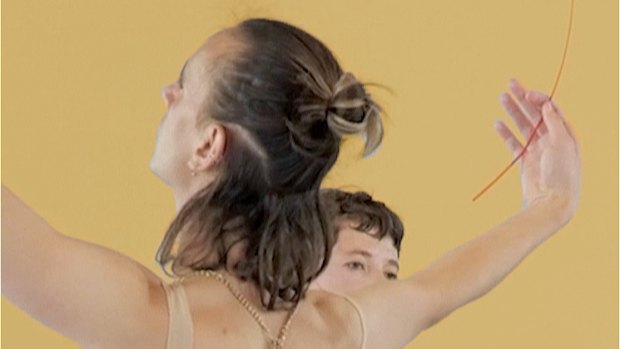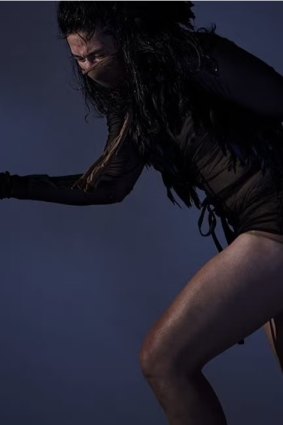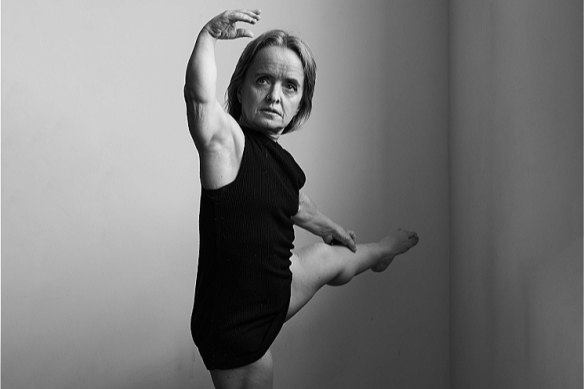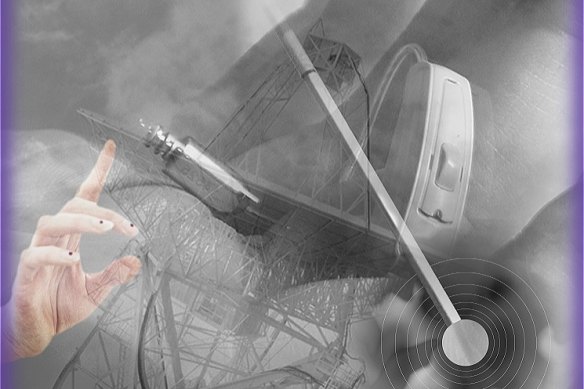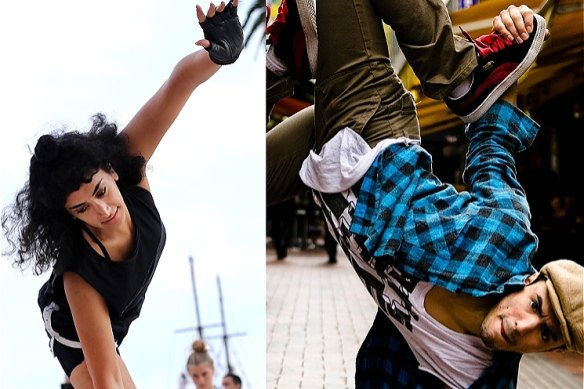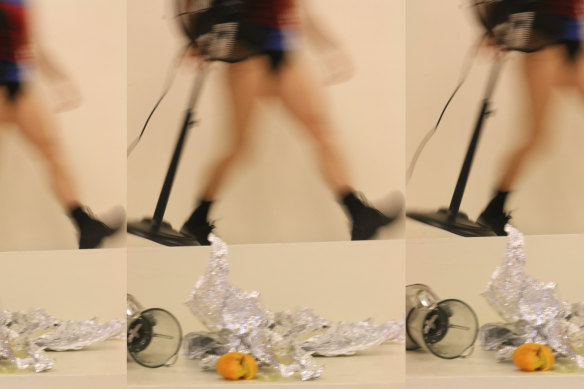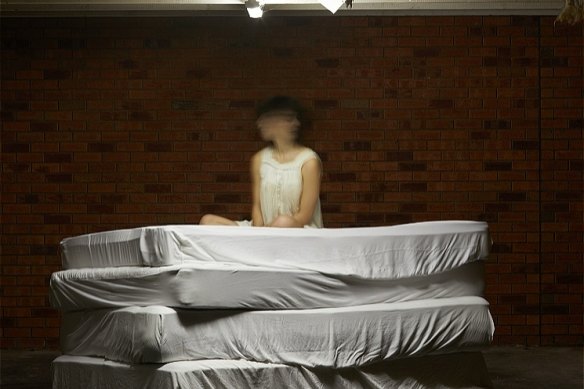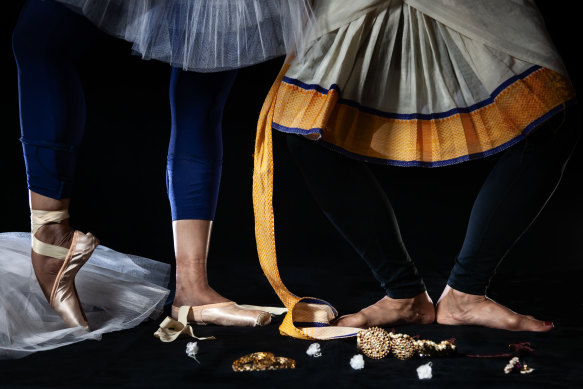Serene bliss: Benjamin Hurley’s five-star Melbourne Fringe dance show
Save articles for later
Add articles to your saved list and come back to them any time.
The Melbourne Fringe has kicked off! Here you can find a collection of reviews covering dance events across the festival.
DANCE
Dunes Rolling Down Dunes | Benjamin Hurley ★★★★★
Temperance Hall, South Melbourne, until October 14
Dunes Rolling Down Dunes is bliss: a serene hour-long duet of swinging arms and soft footwork, performed beneath a magnificent ceiling installation of white sheets.
Dancer and choreographer Benjamin Hurley moves gracefully, tracing out the long phrases with a blank stare and an aura of concentration and pensiveness.
Benjamin Hurley’s Dunes Rolling Down Dunes:
Arabella Frahn-Starkie, meanwhile, explores subtle gradations of intensity, absorbing the movement and letting it change her as the work progresses.
This is a complex piece. Sometimes they dance separately, sometimes in unison. Then they are dancing together but differently. And all parts flow together in the most surprising ways.
The show also features two musicians – Robert Downie and Oliver Cox – who provide an incredible live score with keyboards, bells, chimes, a trumpet and scuffling percussion.
There are too many details and intricacies and refinements to mention: changes in tempo, moments of unexpected exchange, flashes of colour. It simply is must-see contemporary dance.
Reviewed by Andrew Fuhrmann
DANCE
⟪—⟫ | Shian Law ★★★★
Temperance Hall, until October 14
Shian Law: there is a charged quality to the work.Credit: Peter Rosetzky
What is it to carry the weight of history? And what happens when that becomes involuntarily inscribed on your body? ⟪—⟫ is Chinese for “one” – and this is where Law begins, testing out this feeling.
Fusing autobiography with ancient Chinese history, Law – whose practice is known for subverting easy conventionality – intersperses various modes of dance with calligraphy to tell a story about failed promises and gross inequality, and a self that strives to resist assimilation into dominant atmospheres.
As Law poetically says as they retell the story of Zhuangzi’s butterfly dream towards the end of the show, it’s “a subjectivity; an experientialness of being a butterfly versus [being] human”. This is not long after a vigorous corporeal outpouring soundtracked to high-decibel grunge music.
Law shares with the audience memories and knowledges that are held at a deliberate distance despite moments of vulnerability. This effect is heightened by the large windows flanking the heritage-listed venue – there is a charged quality to the work that demands a certain attention. This is true experimental art. Don’t sleep on it.
Reviewed by Cher Tan
DANCE
I Am (Not) This Body | Leisa Prowd ★★★
North Melbourne Town Hall, until October 15
What a difference the right sort of mannequin can make. For this autobiographical solo show, dancer Leisa Prowd has created a suite of new models all cast in her own image.
Leisa Prowd. I am (Not) This Body: poignant but well-judged.Credit: Amanda Fordyce
Supported by the Warehouse Residency at Arts House, I Am (Not) This Body is an exploration of Prowd’s experiences of the world as a woman with a common form of dwarfism.
The stage is cluttered with antique furnishings and figures of different sizes shrouded with white sheets. Prowd clambers over the tables and desks. It’s hard work but her body is resilient.
At first, she performs in clothes that look attractive when styled on a tall mannequin but don’t come in her size. Sleeves whirl around her as she turns and lunges and hangs over chairs.
At last, however, she finds a dress that fits – a symbol of her acceptance of her own body – which leads to a poignant but well-judged moment of audience participation.
Reviewed by Andrew Fuhrmann
DANCE
~~~~~ “…derelict in uncharted space…” | Fayen d’Evie and Benjamin Hancock ★★★★
until October 14 in person Chunky Move Studios, October 21 online
In 1974, Star Trek fans established Project Communicator so that people with vision impairments could boldly go with the show, by audio describing each episode. Paramount shut it down. Co-commissioned by Chunky Move and Fringe, this exhilaratingly inclusive audio-visual dance work – conceived by Fayen d’Evie and Benjamin Hancock – is inspired by that aborted mission.
Fayen d’Evie and Benjamin Hancock’s work is a trippy, immersive piece.
A darkened studio looks for all the world like a ’60s sci-fi TV set, as do the quartet of hypnotic performers’ costumes. You can circle the space freely, observing them inhabit the spirit of season three episode Is There in Truth No Beauty, don headsets and listen to live narration, or read zingily poetic closed captions on a giant screen and its smaller satellites. Ethereal music and interstellar eruptions are felt in reverberation. A trippy, immersive piece, it opens with a reminder: space exploration requires a highly designed environment, so it should be accessible to all.
Reviewed by Stephen A. Russell
DANCE
Tits Out | Shelley O’Meara ★★★
Dancehouse, until October 14
The dancers remove their tops to reveal their bare breasts. They walk around, making direct eye contact while shaking the hand of each audience member. A video work featuring the performers and the show’s title plays alongside a ticking clock sound.
Tits Out, created by Shelley O’Meara: humour and vulnerability.
Tits Out, created by Shelley O’Meara, is an experimental dance work exploring society’s treatment of the humble boob. Many references are made to the preferred euphemisms – melons, milkmaids, teets – as a means of reclamation.
When the show combines amusing dialogue with dance movements, it shines. In particular, a scene where Chelsea Byrne performs as Margot Morales provides pageantry-style dry commentary is a highlight.
Humour and vulnerability are injected when each performer expresses a personal anecdote while crawling over one another in a revolving heap. Unfortunately, the stand-alone dance choreography doesn’t quite have the same impact. An audacious show that occasionally falls short in its execution.
Reviewed by Vyshnavee Wijekumar
DANCE
The Birth and Death of a Physical Artist | Roya the Destroya and Peter Sette ★★★★
Digital on demand
In The Birth and Death of a Physical Artist, Roya the Destroya and Peter Sette aim to show why, despite all the challenges it entails, they pursue life as professional artists.
Roya the Destroya and Peter Sette in Birth and Death of a Physical Artist.
Using dance to demonstrate what it takes off-stage to dedicate themselves to their art form, the show unfolds as a series of autobiographical scenes. From being inspired by pop icons and pop culture as children to taking to the streets to show off their talents, we learn what it has taken for them to appear in front of us here and now. These parts are bound together by a repeated sequence illustrating their perseverance to learn, extend their skills, and develop new modes of expression.
Theirs has been a path with challenges including ableism, injury and exploitation, but also joy. An indefatigable sense of humour carries them through. By the conclusion, the audience has seen behind the curtain, and it makes us appreciate the artistry all the more.
Reviewed by Lefa Singleton Norton
DANCE
Brolga: A Queer Koori Wonderland | Joel Bray ★★★★★
The Substation, October 7
According to some First Nations’ stories, the brolga was transformed from a young boy yearning to perform women’s dances. This blurring of the gender and genre binary perfectly captures the multi-level art party curated by Wiradjuri dancer and Queer AF party creator, Joel Bray.
Brolga: A Queer Koori Wonderland is a multi-level art party.
Brolga: A Queer Koori Wonderland is spread across three floors, each containing unique experiences. There are two dance floors featuring a line-up of some of Melbourne’s best selectors, and rooms with films, tarot readings and mask decorating.
The evening perfectly merges the ethos of a club, performance and art space. A series of roving and stage performers keep the patrons guessing with unexpected interventions, including Bray and collaborators nailing a non-stop party rendition of his choreographed work Considerable Sexual License, and dancer Bendy Ben adorned head to toe in a sequinned leotard with green lasers shooting from his head.
An unforgettable, electrifying evening where, like the fabled brolga, we could dance for eternity.
Reviewed by Vyshnavee Wijekumar
DANCE
Lush | gemma+molly ★★★★★
Dancehouse, until October 7
A blender stands near the audience. The power cord trails off behind a curtain at one side. It has no lid. There’s also an oscillating fan. Apart from that, the stage is bare.
Lush runs until October 7.Credit: Molly McKenzie
A dancer enters, settles onto the floor, spreads her legs and raises them over her head. She stares at the audience through the gap while she holds the pose.
The visual rhyme takes a moment to register: the lines of the legs echo the sides of the container. Then, of course, there are the blades at the base and the engine below.
The erotic potential of this image is developed through repetition, variation and the intensity of the performances. Lush is a work of teasing and menace and an absolute seriousness of purpose.
It’s a compelling piece of experimental dance with a mesmeric sensuality in its simple forms and wild innuendos: full of danger and seduction.
Reviewed by Andrew Fuhrmann
DANCE
Air Hunger ★★★★
Abbotsford Convent, Magdalen Laundry, until October 7
Air Hunger is a dreamy voyage to the half-lit world of the chronically bedridden. It’s also a hugely ambitious production with nine young dancers performing on nine separate mattresses.
The title refers to an acute shortness of breath. It’s caused by a variety of disorders and conditions including chronic fatigue syndrome, which the show’s creator and co-choreographer Lucy Eidelson suffers from.
Air Hunger runs until October 7.Credit: Sonny Witton
And yet Air Hunger isn’t a depiction of any one physiological condition. Rather, it explores the intense emotional and imaginative significance that beds have for us all in this age of exhaustion.
There are many striking moments: the dancers tearing out of their bedsheet cocoons, 18 legs beating on mattresses at once, the construction of a shelter made from mattresses.
It’s an earnest and relatable performance – with dramaturgy by Bridie Noonan and inventive mattress-based choreography by Eidelson and co-choreographer Chiharu Valentino – about the strain of being alive when being alive feels awful.
Reviewed by Andrew Fuhrmann
DANCE
Touch | Deepa Mani and Sheena Chundee ★★★
Dancehouse, until October 7
Touch begins with an airing of grievances but develops into a celebration of cross-disciplinary collaboration and the potential for solidarity between women whose experiences of discrimination are different but resonant.
Deepa Mani, a teacher of Bharatanatyam, is frustrated by a lack of mainstream acceptance for classical Indian dance. Choreographer Sheena Chundee is frustrated by the lack of diversity in classical ballet.
Touch runs until October 7.Credit: Warren Knower
Together, they embody these frustrations as dance. With impatient gestures and rapid footwork, striking her heels on the mat, Mani first tells of her exasperation at having to explain the value of Bharatanatyam.
Chundee, meanwhile, has created a series of expressive contemporary ballet solos for dancer Jasmine Lim, full of the heartache of an artist who strives for acceptance but is rejected.
The solos are poignant, but Touch is most persuasive when the two forms are brought together and performed side by side, with their differences and surprising affinities displayed.
Reviewed by Andrew Fuhrmann
The Booklist is a weekly newsletter for book lovers from books editor Jason Steger. Get it every Friday.
Most Viewed in Culture
From our partners
Source: Read Full Article
